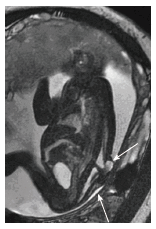Prenatal diagnosis and assessment of congenital spinal anomalies: Review for prenatal counseling
- PMID: 27458551
- PMCID: PMC4945507
- DOI: 10.5312/wjo.v7.i7.406
Prenatal diagnosis and assessment of congenital spinal anomalies: Review for prenatal counseling
Abstract
The last two decades have seen continuous advances in prenatal ultrasonography and in utero magnetic resonance imaging. These technologies have increasingly enabled the identification of various spinal pathologies during early stages of gestation. The purpose of this paper is to review the range of fetal spine anomalies and their management, with the goal of improving the clinician's ability to counsel expectant parents prenatally.
Keywords: Congenital spinal anomalies; In utero magnetic resonance imaging; Prenatal counseling; Prenatal ultrasound.
Figures











References
-
- Bernard JP, Cuckle HS, Stirnemann JJ, Salomon LJ, Ville Y. Screening for fetal spina bifida by ultrasound examination in the first trimester of pregnancy using fetal biparietal diameter. Am J Obstet Gynecol. 2012;207:306.e1–306.e5. - PubMed
-
- Bulas D. Fetal evaluation of spine dysraphism. Pediatr Radiol. 2010;40:1029–1037. - PubMed
-
- Simon EM. MRI of the fetal spine. Pediatr Radiol. 2004;34:712–719. - PubMed
-
- Chao TT, Dashe JS, Adams RC, Keefover-Hicks A, McIntire DD, Twickler DM. Fetal spine findings on MRI and associated outcomes in children with open neural tube defects. AJR Am J Roentgenol. 2011;197:W956–W961. - PubMed
-
- Shekdar K, Feygin T. Fetal neuroimaging. Neuroimaging Clin N Am. 2011;21:677–703, ix. - PubMed
Publication types
LinkOut - more resources
Full Text Sources
Other Literature Sources

